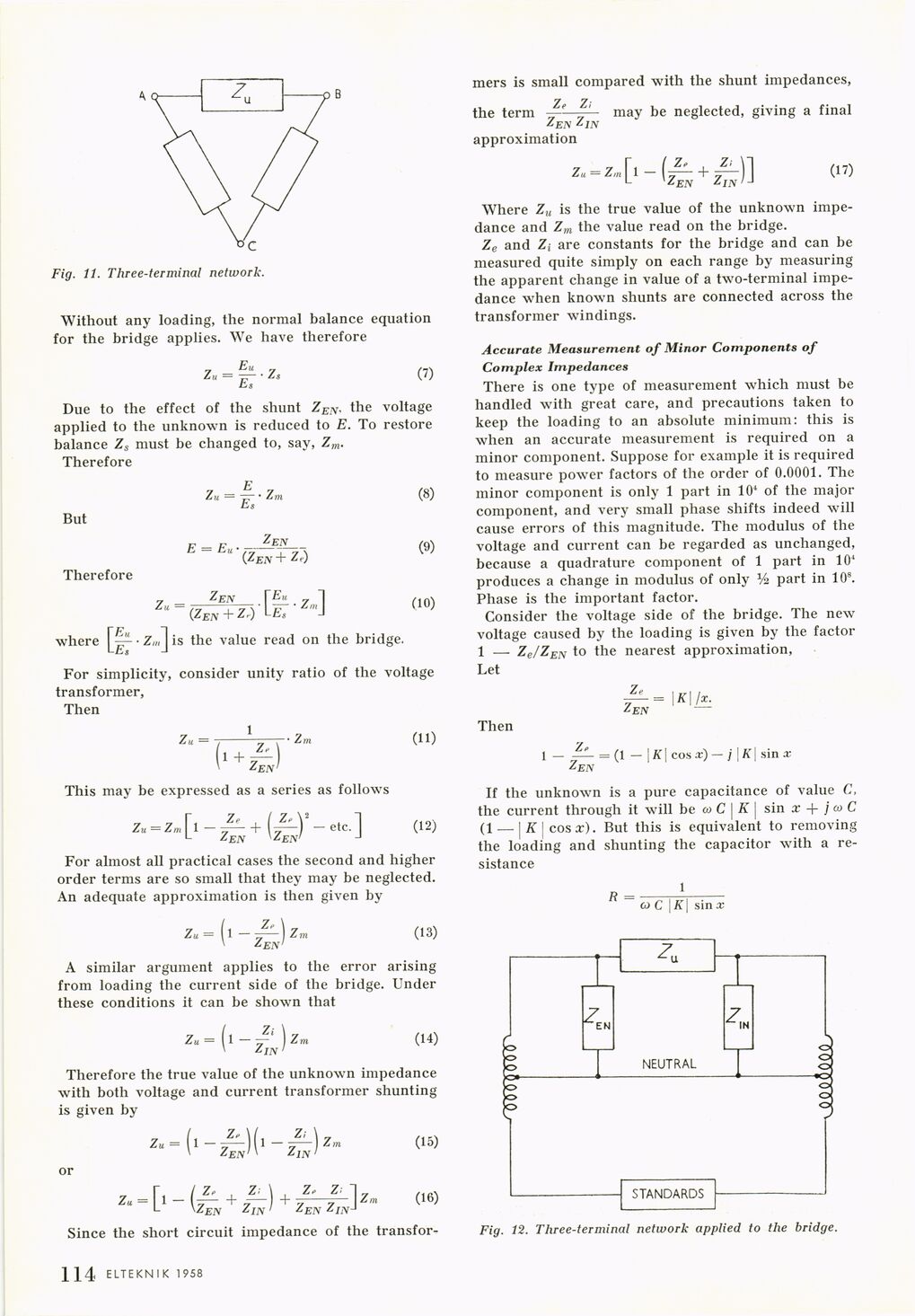
Full resolution (JPEG) - On this page / på denna sida - 1958, H. 8 - The Transformer Ratio-arm Bridge, by Raymond Calvert

<< prev. page << föreg. sida << >> nästa sida >> next page >>
Below is the raw OCR text
from the above scanned image.
Do you see an error? Proofread the page now!
Här nedan syns maskintolkade texten från faksimilbilden ovan.
Ser du något fel? Korrekturläs sidan nu!
This page has never been proofread. / Denna sida har aldrig korrekturlästs.
Fig. 11. Three-terminal network.
"Without any loading, the normal balance equation
for the bridge applies. We have therefore
7 -Eu .7
Es
(7)
Due to the effect of the shunt ZEN, the voltage
applied to the unknown is reduced to E. To restore
balance Zs must be changed to, say, Zm.
Therefore
Zu
Es
But
Therefore
E = Eu • Zen
(ZEi\+Z>)
Zu =
Zen
•tf:-]
(.Zen + Z,) L E
where • Z„,J is the value read on the bridge.
(8)
(9)
(10)
For simplicity, consider unity ratio of the voltage
transformer,
Then
Zu =
1
1 +
Zen
(ID
This may be expressed as a series as follows
Zu = Zm[ 1-Ji-+(*!)’_ etc.] (12)
L A en s^EN’ j
For almost all practical cases the second and higher
order terms are so small that they may be neglected.
An adequate approximation is then given by
■ Zett
(13)
A similar argument applies to the error arising
from loading the current side of the bridge. Under
these conditions it can be shown that
Zu = (l - ) Zi
\ Zriv’
(14)
Therefore the true value of the unknown impedance
with both voltage and current transformer shunting
is given by
fi z’\l 1-—)
I1 ZEJ\ ZlN ’
+ z ) , ** z
Zen ZINI ZEN Z/jyJ
(15)
(16)
mers is small compared with the shunt impedances,
Z Zi
the term may be neglected, giving a final
Zen Zin
approximation
(17)
Where Zu is the true value of the unknown
impedance and Zm the value read on the bridge.
Ze and Zi are constants for the bridge and can be
measured quite simply on each range by measuring
the apparent change in value of a two-terminal
impedance when known shunts are connected across the
transformer windings.
Accurate Measurement of Minor Components of
Complex Impedances
There is one type of measurement which must be
handled with great care, and precautions taken to
keep the loading to an absolute minimum: this is
when an accurate measurement is required on a
minor component. Suppose for example it is required
to measure power factors of the order of 0.0001. The
minor component is only 1 part in 104 of the major
component, and very small phase shifts indeed will
cause errors of this magnitude. The modulus of the
voltage and current can be regarded as unchanged,
because a quadrature component of 1 part in 104
produces a change in modulus of only V2 part in 10s.
Phase is the important factor.
Consider the voltage side of the bridge. The new
voltage caused by the loading is given by the factor
1 —• Ze/ZEN to the nearest approximation,
Let
Ze
Zen
Then
\K\/x.
Zen ^
KI eos x) — j \ K\ sin x
If the unknown is a pure capacitance of value C,
the current through it will be co C | K \ sin x + j æ C
(1 — |/fjcosx). But this is equivalent to removing
the loading and shunting the capacitor with a
resistance
R =
1
o C \K\ sin x
Since the short circuit impedance of the transfor-
Fig. 12. Three-terminal network applied to the bridge.
1 14 ELTEKN I K 1958
<< prev. page << föreg. sida << >> nästa sida >> next page >>